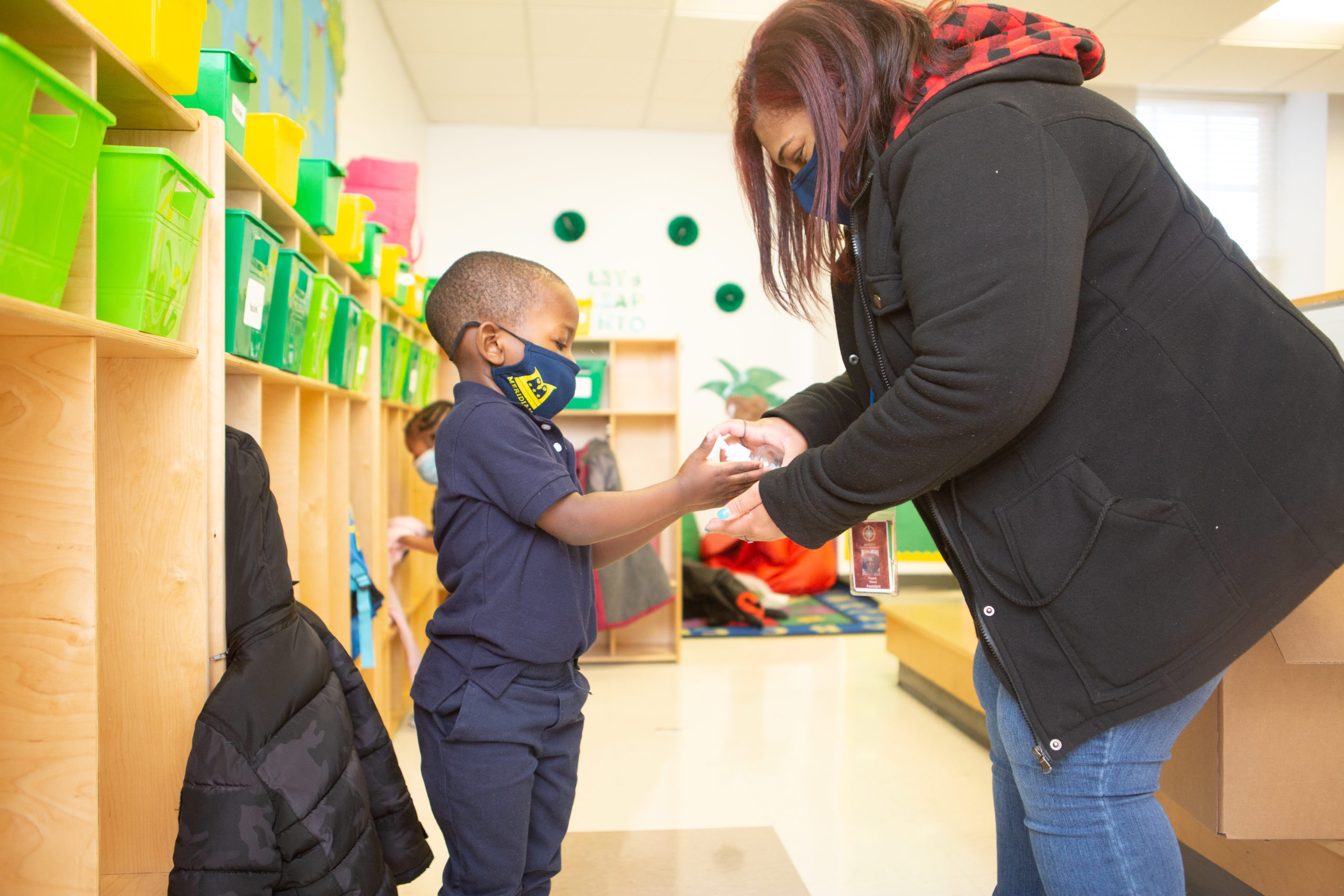
Out-of-school time (OST) programs, such as afterschool and summer programs, are important to many families the District of Columbia. The experience of families is important in understanding what kinds of out of school time (OST) programs and service levels are desired and needed, as well as barriers families face to accessing programs. To understand more about the experience of families with OST programs, the D.C. Policy Center administered a survey to parents and guardians of children who are eligible to participate in OST programs and conducted a listening session with parents who are members of Parents Amplifying Voices in Education (PAVE).
About this series
This publication is part of a series adapted from our full report commissioned by the District of Columbia Deputy Mayor for Education (DME), Needs assessment of out-of-school time programs in the District of Columbia.
Other publications in this series include:
- Chart of the week: D.C. children face unequal access to out-of-school time programs
- Demand for out-of-school time programming shifts, depending on where students live versus where they go to school
- How many out-of-school time seats D.C. has, and where they’re located
- How many more out-of-school time seats does the District of Columbia need?
- How close are out-of-school time programs to where students live?
- Who provides of out-of-school time programs in the District of Columbia?
- Recommendations for out-of-school time programs in the District of Columbia
Access the underlying original report in printable PDF format here.
The experience of families is important in understanding what kinds of out of school time (OST) programs and service levels are desired and needed, as well as barriers families face to accessing programs. To understand more about the experience of families with OST programs, the D.C. Policy Center administered a survey to parents and guardians of children who are eligible to participate in OST programs and conducted a listening session with parents who are members of Parents Amplifying Voices in Education (PAVE).
The survey was disseminated in both English and Spanish by PAVE to a total of 181 households, representing 318 children. To determine participants, PAVE collected a sample of their participating parents and guardians for whom they had complete demographic information and selected 200 parents or guardians that were representative of D.C. populations (by race, income, ward, etc.). PAVE sent messages to the selected parents and guardians asking if they wanted to opt-in to participate, and PAVE sent the survey to those that opted in. Those who completed the survey were given $50 as an incentive.
Family and child demographics of survey respondents
The plurality of survey respondents live in Ward 8, have household incomes below $50,000, are Black, and are not Hispanic. 82 percent of the respondents had two or fewer children and youth in their households.
Demographic characteristics of survey respondents

Children and youth captured by the survey were evenly distributed across grade levels. Majority of the children and youth speak English and about 16 percent speak Spanish. Three percent of the children were learning English as a second language, and twenty percent of the children and youth have Individual Education Plans (IEPs) or are in a Special Education program.
Demographic characteristics of children and youth who are in care of survey respondents
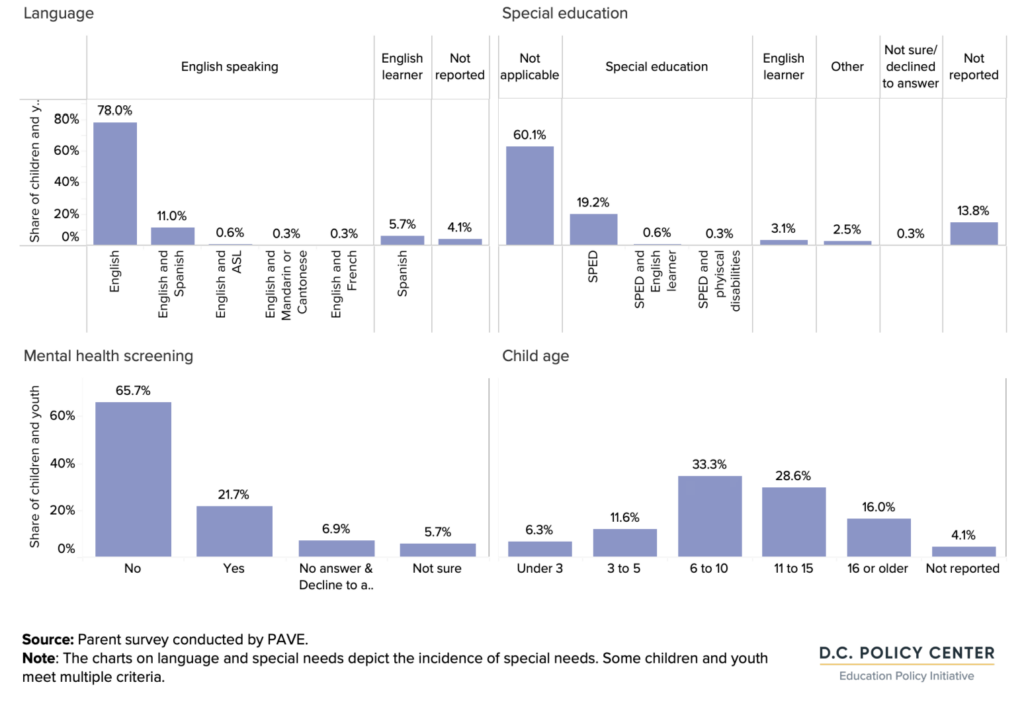
Participation in OST programs and barriers to access
While most households have a child who is currently participating in or had previously participated in OST programs (74 percent of households), barriers still exist for many households. Of the households that wanted to participate in OST programs but aren’t currently participating, the most cited reasons were that the programs were too expensive, there were no appropriate or convenient transportation options to or from the program, programs were hard to get into, and households had a difficult time finding information about the programs themselves. Additionally, although not noted in this survey, language barriers are an obstacle for many families to access OST programming.
Exposure to OST programs by age group and household income
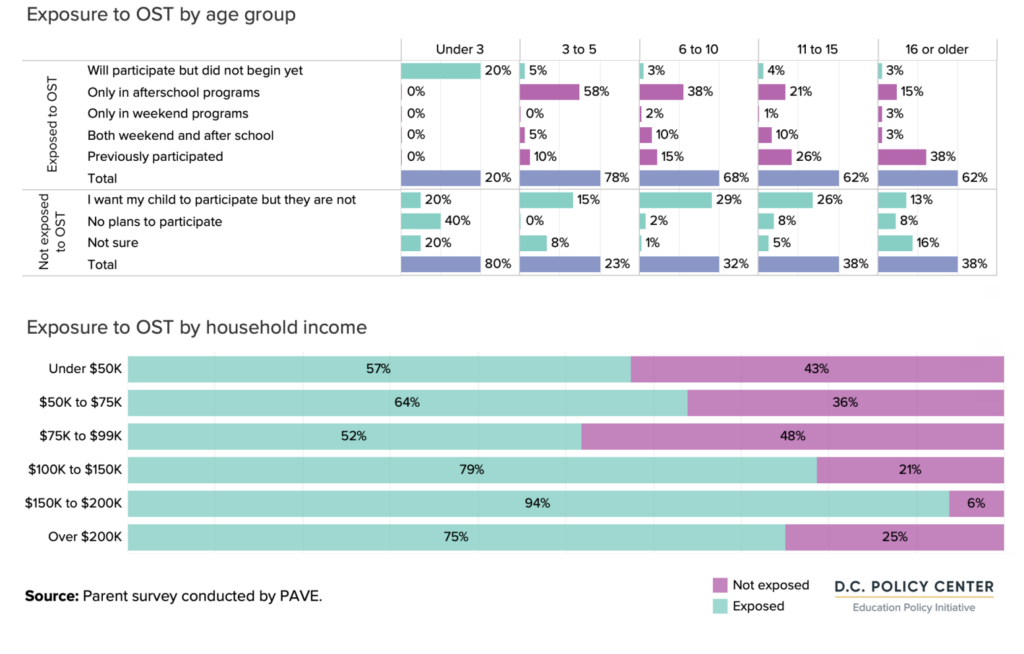
The most commonly mentioned reasons for not participating in OST programs is cost. This is an important finding because it highlights that income-based targeting in publicly funded OST programs may be a viable public policy in assigning relatively few seats. For every 10 parents or guardians who reported program costs as a barrier, 8.7 reported lack of transportation options, and 8.2 reported the difficulty to get in a program. The fourth commonly reported barrier is the lack of easily accessible information on OST programs.
Relative ranking of reasons for not participating in OST programs reported by households
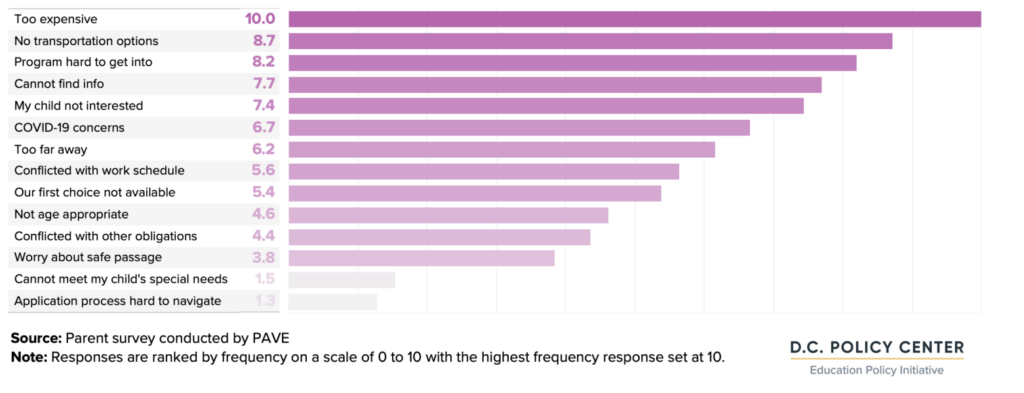
Reasons for not participating in OST programming varied significantly by ward. Parents in Ward 8 more frequently reported that programs were too far away, conflicted with work schedules, or that they lacked transportation. Families in Wards 8 and 5 more frequently found that programs were too expensive or had difficulty with the application process. Half of the families that reported difficulty meeting special needs of students most frequently live in Ward 4.
Reasons for not participating in OST programs by child and ward
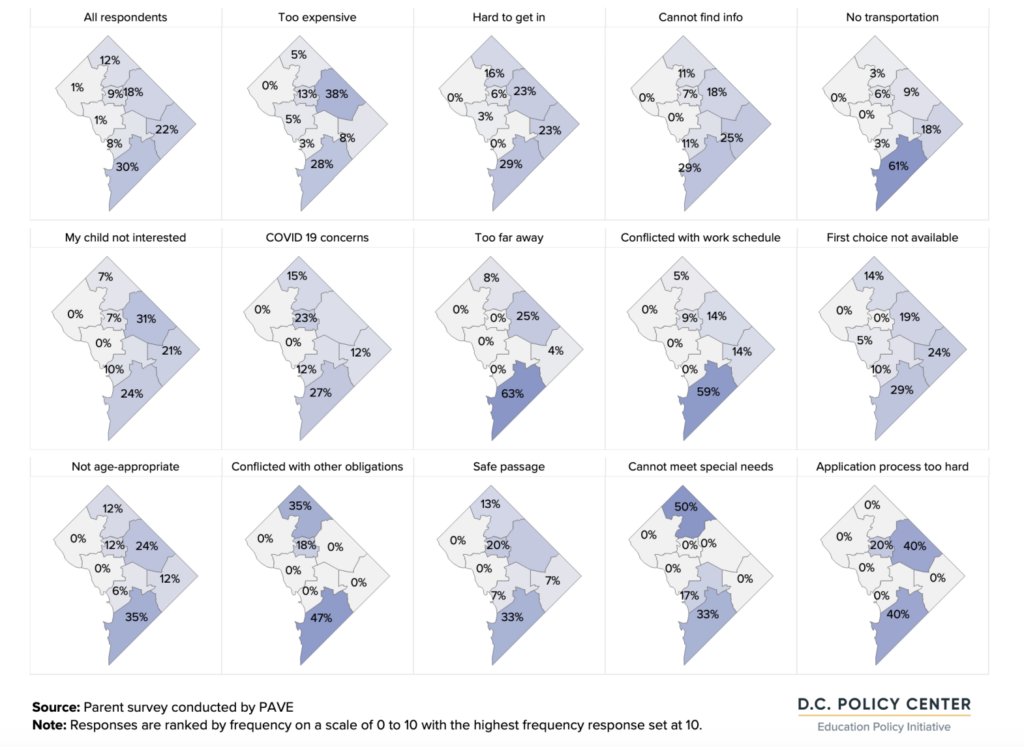
How families find information about OST programs
To find information on OST programs, household survey respondents most frequently cited their children’s schools (195 mentions), followed by friends and family (131), social media (106), and recreation centers (100). Learn24 was rarely used by households to find programs, cited a total of 12 times. When asked about how households would prefer to receive information about OST programs, households most frequently mentioned their children’s school (246), social media (127), recreation centers (112), and PTA meetings (106).
When asked about finding specific program information such as hours, locations, program content, or accommodations for special needs, households had the most difficulty finding information on program accommodations for children with special needs including bilingual staff for English learners and staff trained to accommodate children with disabilities.
Preferred source of information for OST programs
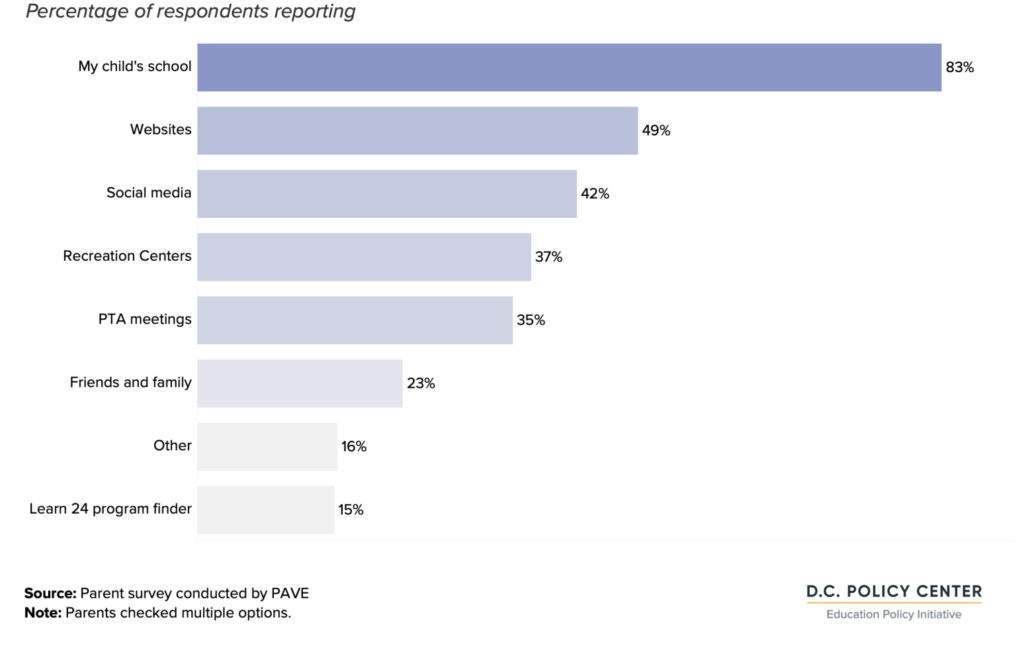
Reasons families participate in OST programming
Parents choose to send their children to OST programs for a variety of reasons including social development, academic support, learning new skills, and childcare. When asked about the most important outcome of OST programs, households most frequently mentioned social and emotional development, followed by learning a new skill or topic, keeping kids safe, and developing creative or artistic skills.
Distribution of reasons for participating in OST programs by household income
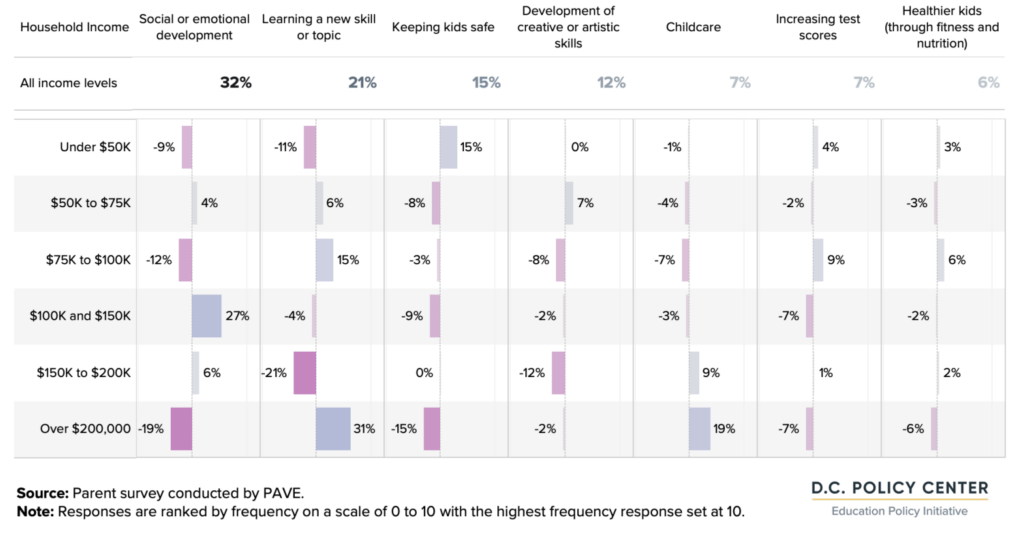
Listening session themes
To obtain qualitative information about the experience of parents and guardians, the D.C. Policy Center incorporated information from open-ended responses in the survey distributed to parents and guardians, as well as information from a listening session. The D.C. Policy Center conducted a listening session with PAVE parents in October 2022, in which parents were asked about their experience with OST programs. The main issues mentioned by parents included:
Transportation
Many parents mentioned that while there is often transportation between children’s homes and schools, there were often no appropriate or timely transit options between schools and programs, or between programs and where students live. Many students reportedly do not feel safe on public transit, exacerbating this issue. Transportation between schools, programs, and where students live can be particularly important for children with disabilities who need separate transportation options or assistance.
Affordability
Many parents mentioned that summer programs and high-quality programs were unaffordable to them. Parents mentioned that when they found affordable programs, they filled up very quickly and often have sign-up processes months in advance. Furthermore, first-come, first-serve registration processes, even when available online, created accessibility issues for some parents. This was particularly a problem for parents and guardians who could not access a computer during limited sign-up windows or specific registration times due to work schedules, limited home internet access, or digital literacy barriers.
Additionally, many of the affordable or subsidized programs were less specialized and seen as lower quality than many of the programs about particular interests. Specialized camps for example in STEM, robotics, and the arts may cost hundreds or thousands of dollars a week. Many parents said they sent their children to programs in Maryland or Virginia, which had more affordable programming for areas that interested their children (including STEM and some sports).
Difficulty finding programs and enrolling
Many parents mentioned that there is a lack of communication between OST programs, schools, and parents. Currently, parents are having trouble accessing information about OST programming, and often struggle to sign up when they do find programs. Many programs fill up quickly, have confusing application requirements, or require signing up online at a specific time. This creates issues for parents who do not have internet or devices, have language barriers, or are essential workers and cannot be online at certain times during the day. Some parents mentioned tutoring others in their community on the sign-up process for OST programs and wished for there to be informational sessions on this in schools.
Programs vary widely by price, content, quality, and sign-up processes, which may happen many months before programs start. Parents most frequently mentioned getting information about programs through their children’s schools, friends and family, social media, and online. However, many felt that communication from schools could be much better utilized and that they did not have a complete understanding of all the options available to their children. The District has invested heavily in Learn24 as a search function for OST programming, however when asked to rank how they receive information, parents ranked learn24 last as a source of information for OST programs. Finally, parents with children who have special needs expressed that it was very difficult to determine which programs could accommodate their child’s specific needs, and when programming was found, it was not always possible to get to on public or school-provided transportation.
Detailed information on where D.C. public school students live and go to school, capacity of OST programs and locations, estimated gaps across the city and at the neighborhood level, and the experience of providers can be found in the main text of our report.
